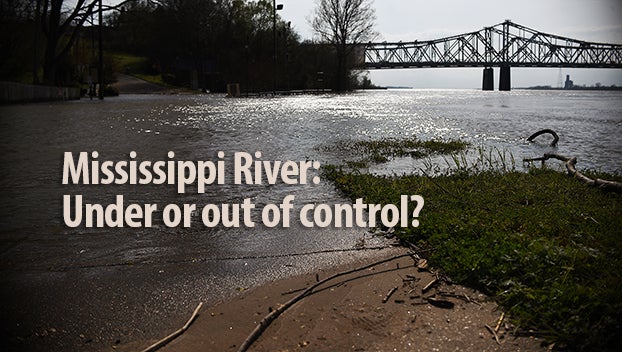Sunday Focus: Recent floods have sparked fierce debate about control of Mississippi River
Published 1:11 am Sunday, March 18, 2018
NATCHEZ — The Mississippi River reached its fourth-highest crest ever at Natchez on Saturday — yet based on recent history, that figure is just par for the course.
With the river exceeding the 57-foot level at the Natchez gauge, this year’s flood stage would fall short of only three in Natchez’s recorded history. Two of those occurred within the past 10 years, with by far the worst-ever flooding from the river in this area coming in 2011 at a record-high 62 feet.
But a look at the top five river levels ever, including this year, reveals a disturbing trend: Every flood on the list but one has occurred in the past decade.
The National Weather Service river data, which tracks all the way back to the turn of the 20th century, shows that the river at Natchez has either reached a major flood stage at 57 feet or come within a quarter of an inch of that mark four times since 2008.
So, does a smoking gun exist for this trend, or can this be attributed to the typical ebbs and flows of the river?
The answer depends on whom you ask.
If you pose the question to Howard Jones, owner of the J.M. Jones Lumber Company located on the low-lying banks of the river, a solution exists to fix the problem — and he fears what could happen if that does not happen.
“Something’s changes about the river, but nothing’s being changed about the way we’re addressing it,” Jones said.
Jones, along with father-and-son duo Kelley and George Williams, believes the way the river has been engineered has led to increasingly treacherous conditions for batture land — floodplain areas that lie between levees.
These areas, such as Kelley Williams’ land at Lake St. Mary, pervade the Miss-Lou.
Both Kelley and George Williams are part of a nonprofit think-tank called Bigger Pie Forum, which has spent the past few years attempting to effect change through dialogue with both Congress and the U.S. Army Corps of Engineers.
When boiling down Kelley Williams’ argument for simplicity, he points to what he believes are outdated Corps policies that have caused water to flow exceedingly fast down river. That increase in flow in turn, he argues, has contributed to higher stage levels and higher risk for vulnerable batture land.
Essentially, he pinpoints the Old River Control Structure (ORCS) approximately 40 miles south of Vidalia as the key to both the problem and solution for the area’s flooding problems.
The structure regulates how much water flows out of the Mississippi and into the Atchafalaya River. By distributing the water into the Atchafalaya, the structure prevents the Mississippi from changing course completely into the Atchafalaya, which would pose a great threat to New Orleans.
When the Corps finished the complex in the early 1960s, the flow distribution averaged 30 percent into the Atchafalaya to later drain in the Gulf of Mexico at Morgan City, while the rest continues down the Mississippi until discharging into the Gulf past New Orleans.
In layman’s terms, Kelley Williams argues that the distribution could be changed to make more water flow into the Atchafalaya to accommodate the higher flow level seen over time.
But some Corps members see things differently.
Both Executive Director of the Mississippi River Commission Charles Camillo and Corps of Engineers Watershed Division Chief Joey Windham said they express concern for the high flood stages seen in areas such as Natchez, but they disagreed with any assertion that the Corps’ system is not working.
Considering Kelley Williams’ hope to utilize the ORCS, Camillo said the idea of tipping the distribution more into the Atchafalaya is not feasible.
“Some of those folks would like to see us increase that distribution to, say, 50-50 to draw down stages on the Mississippi River, but that’s just not how the system is designed,” Camillo said.
Flood control with the Mississippi is, as Williams would call it, a “zero-sum game,” meaning action taken to reduce floods in some areas will in turn cause stages to rise in other places.
Windham alluded to this premise when he reasoned why changes to the ORCS would not be wise.
“It’s a balance of how much you drop the Mississippi side and how much you raise the backside,” Windham said. “We’ve done engineering studies to show which is the best way to do that for the benefit of all the system.
“We went back and looked at that, and we came up with the same conclusion — to change that percentage and to drop stages on one side has a significant increase in stages on the backside.”
The two also pointed to the wavering nature of the river, often going back and forth between periods of high and low stages.
Camillo noted that following the massive floods of 2011, the next year brought a substantial drought.
Kelley Williams and Camillo have been in contact with each other for some time and both acknowledge each other’s point of view, but those viewpoints often do not align when it comes to flood control.
Williams claims that the Corps continues on with its policies that have been instated for decades with its hands tied by Congress.
“The Corps doesn’t deal with that, because it says, ‘We just follow orders … It’s not our fault a million acres of batture land is flooding; we just do what we’re told,’” Kelley Williams said.
But Camillo and Windham said the system is operating efficiently and does not need retooling. They claim the Corps’ Mississippi River and Tributaries Project, authorized by the 1928 Flood Control Act to prevent flooding in the lower Mississippi Valley, has saved areas along the river a whopping $1 trillion of damage.
Further, Camillo said he believes Congress would listen to the Corps and make legislative changes as the Corps deemed necessary.
“This is my belief, is that if we went to (Congress) and said, ‘Hey, this system is not operating the way it needs to and we think we could do it better this way,’ I think they would change the laws,” Camillo said. “But we’re not finding that it’s not operating in the optimum level within the realm of possibility.”
No matter which group is right about what should happen with the ORCS, the fact still remains that today, Howard Jones looks on with concern as the waters creep toward his business. Though this year’s waters will not do him in, Jones fears what the future might hold.
“I guess the question I’ve got is, ‘Do we have to wait ’til Vidalia goes underwater or New Orleans or for the river to literally go to Morgan City?” Howard asked. “Do we have to wait for that to make a change? Maybe so.”
“I hope not,” Kelley Williams said.






